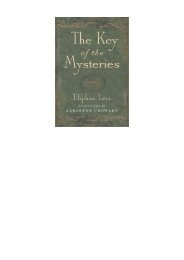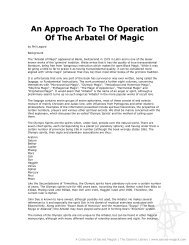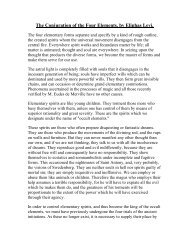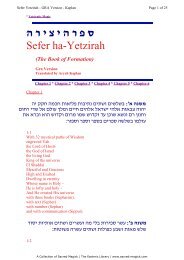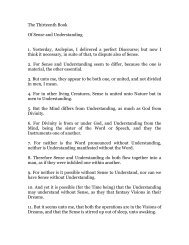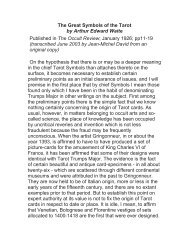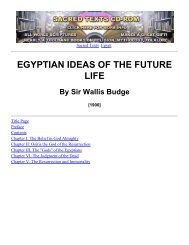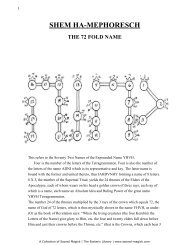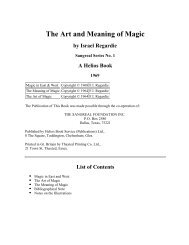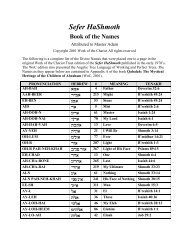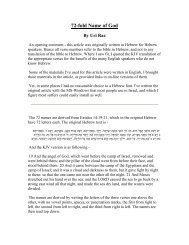Goetia - Holy Order of the Golden Dawn Canada
Goetia - Holy Order of the Golden Dawn Canada
Goetia - Holy Order of the Golden Dawn Canada
You also want an ePaper? Increase the reach of your titles
YUMPU automatically turns print PDFs into web optimized ePapers that Google loves.
In <strong>the</strong> c section <strong>the</strong> fifth <strong>of</strong> <strong>the</strong> voces magica is OÖÖ not DÖÖ; similarly OÖ not DO after<br />
SABRIAM in <strong>the</strong> final section. The miscopying occurred in <strong>the</strong> execrable de Lawrence piracy <strong>of</strong><br />
<strong>the</strong> Goëtia and has been perpetuated by o<strong>the</strong>r writers, probably because in <strong>the</strong> blackletter typeface<br />
used by Crowley capital D and O were similar (this e-text uses JSL Blackletter, designed by Jeff<br />
Lee, which is very similar to <strong>the</strong> face used in <strong>the</strong> 1904 edition, differing only in a few letters e.g.<br />
capital Z). Similarly <strong>the</strong> lower-case x and r are very similar, so de Lawrence miscopied Abrasax<br />
as Abrasar in <strong>the</strong> third and sixth sequences <strong>of</strong> voces magica.<br />
The Initiated Interpretation <strong>of</strong> Ceremonial Magic.<br />
This essay was reprinted in <strong>the</strong> notes to Crowley’s Sword <strong>of</strong> Song and in turn reprinted in vol. ii<br />
<strong>of</strong> his Collected Works. Additional footnotes from <strong>the</strong> latter publication have been included.<br />
Preliminary Definition <strong>of</strong> Magic.<br />
Crowley scholar Martin Starr (cited in an editorial note to Crowley’s Magick: Book 4 Parts I-IV,<br />
Weiser, 1994) has sourced this to a 1656 English translation <strong>of</strong> Themis Auræ, a Rosicrucian work<br />
by Michael Maier.<br />
Brief Introductory Description.<br />
The Lemegeton is a 17 th -century English compilation <strong>of</strong> magical texts attributed to Solomon. The<br />
Goëtia is itself composite: <strong>the</strong> praxis appears based partly on <strong>the</strong> Fourth Book <strong>of</strong> pseudo-Agrippa<br />
and partly on <strong>the</strong> Key <strong>of</strong> Solomon; <strong>the</strong> conjurations are closely or identically worded to those in<br />
Robert Turner’s English translation (pub. 1655) <strong>of</strong> <strong>the</strong> Heptameron, a 16 th -century Grimoire <strong>of</strong><br />
planetary magick (falsely attributed to Peter <strong>of</strong> Abano) which was bound up with <strong>the</strong> Fourth<br />
Book, and <strong>the</strong> catalogue <strong>of</strong> spirits is an adaptation <strong>of</strong> <strong>the</strong> “Book <strong>of</strong> <strong>the</strong> Offices <strong>of</strong> <strong>the</strong> Spirits”<br />
published by Wier in 1563 as Pseudomonarchia dæmonum from a magical MS. in his possession.<br />
This latter had 69 spirits; <strong>the</strong> compiler <strong>of</strong> <strong>the</strong> Goëtia added some to bring <strong>the</strong> number up to 72 in<br />
accordance with <strong>the</strong> legend in <strong>the</strong> Pseudomonarchia which speaks <strong>of</strong> <strong>the</strong> 72 chief spirits bound up<br />
in <strong>the</strong> brazen vessel by Solomon. Fur<strong>the</strong>r, as Petersen points out, <strong>the</strong> fourth spirit in Wier’s list,<br />
<strong>the</strong> Prince and Duke Pruflas or Bufas, is omitted in <strong>the</strong> Goëtia, and was also omitted in <strong>the</strong><br />
version <strong>of</strong> <strong>the</strong> Pseudomonarchia published by Scot in Discoverie <strong>of</strong> Witchcraft (1584), from a<br />
MS. collection <strong>of</strong> magical rituals in English compiled by one “T.R.” The Goëtia also perpetuates<br />
a few o<strong>the</strong>r errors or oddities from that translation.<br />
The Theurgia Goëtia lists 31 principal spirits and enumerates an astronomical number <strong>of</strong><br />
subordinates <strong>of</strong> whom relatively few are named; <strong>of</strong> <strong>the</strong> 31, 20 are referred to <strong>the</strong> points <strong>of</strong> <strong>the</strong><br />
compass and <strong>the</strong> o<strong>the</strong>r 11 are said to wander and have no fixed place. It is possible that <strong>the</strong><br />
Theurgia-Goëtia was partly based on <strong>the</strong> Steganographia <strong>of</strong> Tri<strong>the</strong>mius by someone who did not<br />
realise that <strong>the</strong> latter was primarily a work <strong>of</strong> cryptography. The apparently oxymoronic title<br />
(historically gohteia was used as a term <strong>of</strong> abuse by those who claimed to practice qeourgia for<br />
what o<strong>the</strong>r magicians did) is accounted for by <strong>the</strong> mixed nature <strong>of</strong> <strong>the</strong> spirits (and <strong>the</strong> fact that <strong>the</strong><br />
words had shifted somewhat in meaning by <strong>the</strong> Renaissance).<br />
The Ars Paulina contains a catalogue <strong>of</strong> Angels for <strong>the</strong> 12 hours <strong>of</strong> <strong>the</strong> day and night, and for<br />
<strong>the</strong> 12 signs and 360 degrees <strong>of</strong> <strong>the</strong> Zodiac; <strong>the</strong>y are also attributed to <strong>the</strong> seven classical Planets.<br />
The Ars Almadel is probably <strong>of</strong> medieval origin: it divides up <strong>the</strong> powers it summons into<br />
four “Altitudes”, seemingly referred to <strong>the</strong> cardinal points <strong>of</strong> <strong>the</strong> Zodiac. Both <strong>the</strong> Pauline Art<br />
and Art Almadel (alongside <strong>the</strong> Notary Art and “Art <strong>of</strong> Revelations” concerning which latter I<br />
have no fur<strong>the</strong>r information) were denounced by Agrippa in his de Vanitate.<br />
The Ars Nova is a kind <strong>of</strong> appendix which appears in one MS. (BL Sloane 2731) where it<br />
occupies one and a half sides <strong>of</strong> a single folio leaf: it comprises an extended prayer associated<br />
75




